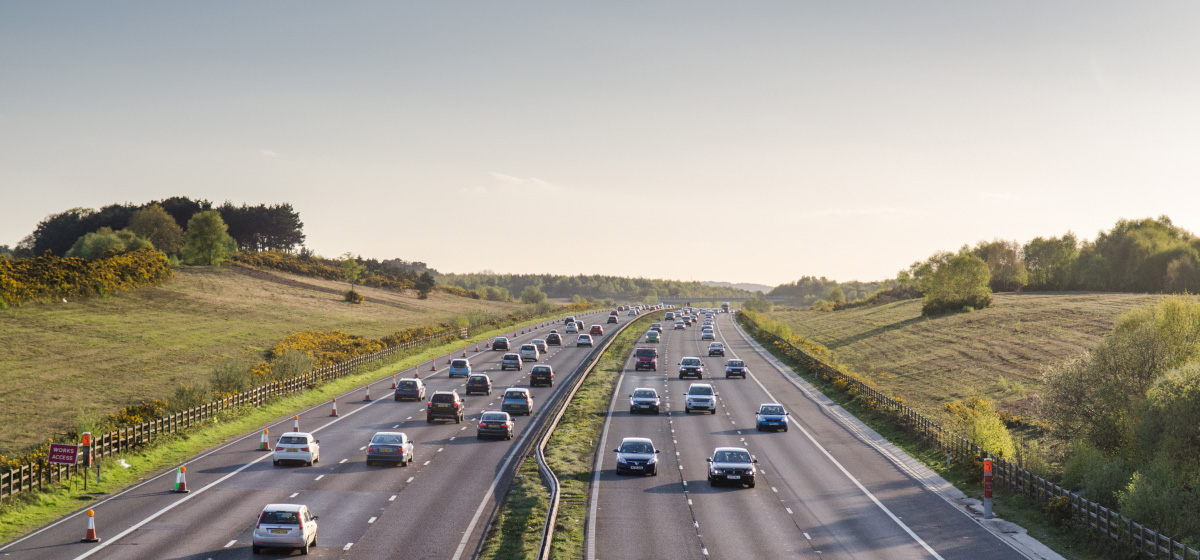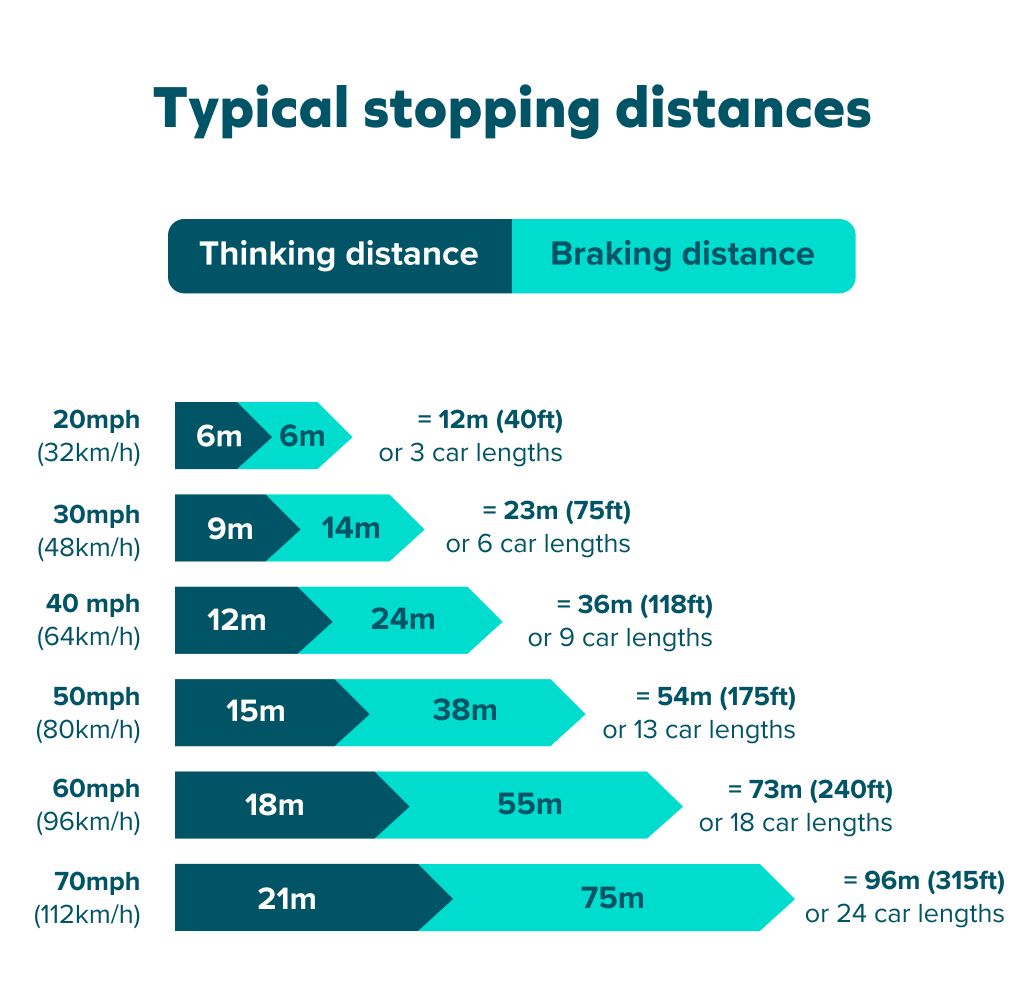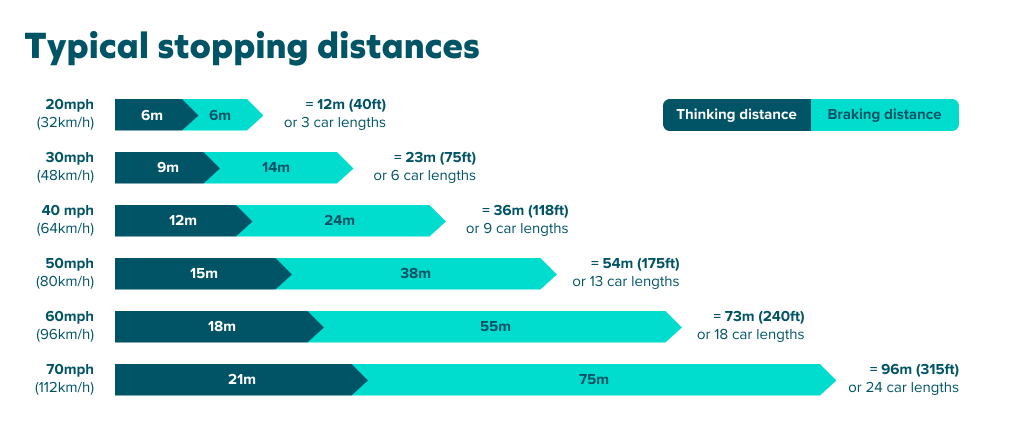Knowing your stopping distances is essential if you want to pass your driving theory test. It doesn’t matter if you’re a learner driver, new driver or experienced driver, knowing your stopping distances will make you a safer driver on the roads.
What is stopping distance?
The stopping distance is the distance a driver needs to safely bring the moving vehicle to a complete stop. This includes the time it takes you to react, which is known as the thinking distance; plus the time it takes you to physically stop the car, which is known as the braking distance.
Why do we need to know stopping distances?
Stopping distances let you know how much space to leave between you and the car in front. Leaving enough room will mean that you’ve got a clear view of the road ahead. It also means, if someone brakes suddenly in front of you, there’s enough distance for you to stop and not crash into the back of them.
How fast your car is going has a huge impact on road crashes. Knowing your stopping distance for different speeds and conditions can not only prevent crashes but can also mean there’s less impact when crashes do happen.
Stopping distance formula
The Highway Code calculate the stopping distance by adding together the thinking distance and the braking distance. They split this up by different speeds to show how much longer it will take you to stop the car when you’re travelling at a faster speed.
The stopping distance formula is:
Stopping distance = thinking distance + braking distance
Stopping distances at different speeds
The stopping distances you’ll need to remember for your theory test are listed in the chart below. But remember that these numbers can be impacted by different factors such as the weight of the car, how alert the driver is and road conditions.
Stopping distance at 20mph
6m thinking distance + 6m braking distance = 12 metres
The stopping distance at 20mph is 12 metres (40 feet) which is the same as about three car lengths.
Stopping distance at 30mph
9m thinking distance + 14m braking distance = 23 metres
The stopping distance at 30mph is 23 metres (75 feet) which is the same as about six car lengths.
Stopping distance at 40mph
12m thinking distance + 24m braking distance = 36 metres
The stopping distance at 40mph is 36 metres (118 feet) which is the same as about nine car lengths.
Stopping distance at 50mph
15m thinking distance + 38m braking distance = 53 metres
The stopping distance at 50mph is 53 metres (175 feet) which is the same as about thirteen car lengths.
Stopping distance at 60mph
18m thinking distance + 55m braking distance = 73 metres
The stopping distance at 60mph is 73 metres (240 feet) which is the same as about eighteen car lengths.
Stopping distance at 70mph
21m thinking distance + 75m braking distance = 96 metres
The stopping distance at 70mph is 96 metres (315 feet) which is the same as about twenty-four car lengths.
How to calculate stopping distance
Don’t worry if you’re feeling a bit overwhelmed with the idea of remembering all these numbers. There’s a handy way to calculate the stopping distance at different speeds.
To calculate the stopping distance in feet, all you need to do is multiply the speed you’re travelling at by intervals of 0.5, starting from 2 at 20mph.
| Speed | Multiply by | Stopping distance (in feet) |
|---|---|---|
| 20mph | x2 | 40 feet |
| 30mph | x2.5 | 75 feet |
| 40mph | x3 | 120 feet |
| 50mph | x3.5 | 175 feet |
| 60mph | x4 | 240 feet |
| 70mph | x4.5 | 315 feet |
What is thinking distance?
The thinking distance is the distance the car would travel in the time it takes between the driver realising they need to stop and applying the brakes.
When there’s hazards ahead, this short amount of time it takes for the driver to react can make all the difference. Plus, the faster you’re driving, the further you’ll travel in that time.
According to the Highway Code, thinking time is just under 0.7 seconds. That’s why the thinking distance at 20mph is only 6m compared with 21m at 70mph.
Factors that affect thinking distance
The thinking distance will change depending on how quickly the driver can react. Factors that affect the driver’s reaction time, other than speed are:
- Alcohol or drugs will slow down the reaction time of the driver and increase the thinking distance. Check out the drink driving limits to make sure you don’t put yourself or other drivers in danger.
- Tiredness will slow down the thinking distance and make drivers less alert. That’s why it’s so important to take regular brakes, especially when you’re driving on the motorway.
- Distractions will slow down the thinking distance. Whether it’s a noisy road trip partner or your mobile phone, distractions will mean it takes you longer to react.
- Visibility on the road will slow down the thinking distance, such as if it’s raining or foggy.
What is braking distance?
The braking distance is the distance a car will travel before coming to a complete stop, after the driver has applied the brakes. The faster you’re travelling, the more momentum your car will have and the higher the braking distance. It’s also important to remember there are some other factors that will affect braking distance, as well as the speed of the car.
Factors that affect braking distance
- Weather conditions such as wet or icy roads will increase the braking distance of a vehicle.
- The condition of the car’s tyres will impact the braking distance. All tyres have different grip but you should also keep on top of your tyre tread depth and pressure. Check out our essential car maintenance checklist to make sure you keep your tyres in tip top condition.
- The condition of the car’s brakes, such as worn suspension, will impact the braking distance.
- The heavier the car is, the higher the braking distance.
How much can stopping distance increase in icy conditions?
The stopping distance can be up to 10 times longer on icy roads. How good your tyres are will impact how much stopping distances increase in icy conditions. Check out our tips for driving in winter to make sure you’re prepared.
HINT: This is a common question on the driving theory test.
Which car has the fastest braking distance?
We highly doubt any of you will be driving one of these, or that we’d even insure you if you did! But you never know, it may prove to be a useful piece of trivia for your next quiz. According to Fastestlaps, the Ferrari F2004 has the best braking distance of 16m (53ft). Impressive!
Learning to drive?
If you’re learning to drive, you might find it helpful getting in some practice outside of your driving lessons. When you’re in the car, try and think about how much space you’re leaving between you and the car in front and stay alert to keep your thinking distance as low as possible.
With our learner driver insurance, you can get flexible, affordable cover to suit your needs. With pay-as-you-go insurance and rolling monthly subscription options available, you can get just the cover you need, for as long as you need.


